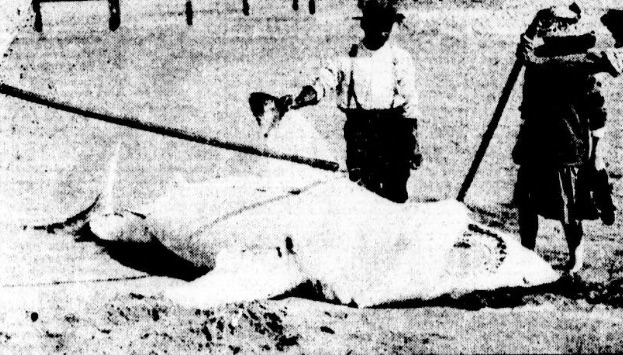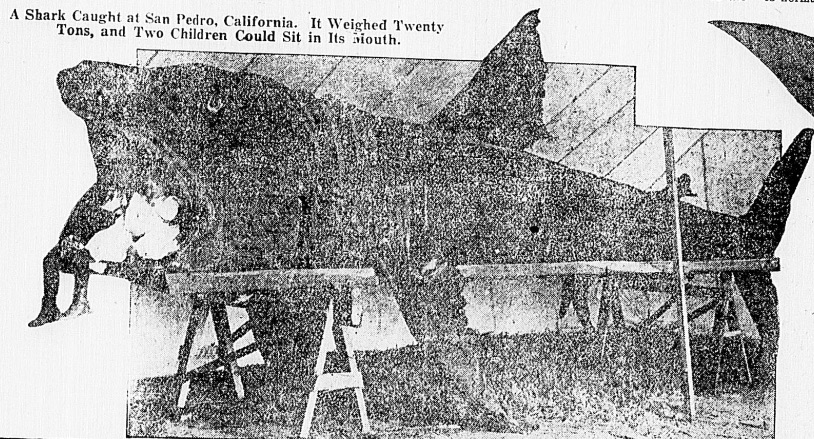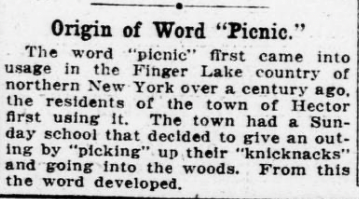
The majestic shark commands respect and, with that, plenty of fear. Shark attacks on people have been happening ever since the first person decided to enter the salty waters of the ocean, but reports of shark attacks did not start filling the newspapers until the 1870s.
The gruesome accounts elicited a long forgotten primal fear and sympathy for those who lost their lives to the “beasts” of the sea. The reports were brutal and left little to the imagination of the damage a shark could do to the human body, but in spite of the grisly details people still entered the shark infested water, momentarily oblivious to what awaited them.

Pulled Under And Never Seen Again
The sea claims numerous lives each year, from child to adult. Visitors and seasoned professionals are at her mercy, and she can strike at the most benign moments.
Edward Bailey, a lighthouse assistant keeper at the Cape St. George Lighthouse in Jervis Bay, decided to spend some quality time with his two sons in November, 1895. He took the young boys fishing off the rocks near the lighthouse and as they stood and waited for something to bite their lines, a huge wave came up, and washed over the rocks.
Mr. Bailey, who was closest to the water, was knocked over and pulled out to sea by the current. He recovered quickly enough and began to swim back to the rocks and his sons. Halfway there, he needed to take a quick breather and floated on his back for a moment. That was then the shark came up. It grabbed Mr. Bailey by his feet and pulled him under. His body was not recovered. [1]
The Stranger Did His Best
Of all the old reports of shark attacks, the hardest to read are those that happened to young children. Unfortunately, deadly attacks on children were the most common and often reported shark attacks in the nineteenth century.
In January, 1896, five young boys were swimming in Johnston’s Bay, Pyrmont. As the boys splashed about, an older man on the shore watched and saw a large shark swim towards the boys. Its tail struck one of the boys as its jaws seized hold of eleven-year-old William Reddie.
The man, Alfred Johnson, acted quickly and ran into the water, fully dressed, to rescue the boy. When he reached Reddie, the boy had only enough strength reach out his hand to the man, but it was enough for Alfred to grab hold of.
A tug-of-war ensued and eventually Alfred was able to get the boy free from the shark, but it was a bittersweet moment. In spite of the stranger’s best efforts, the boy had lost part of a foot and a portion of his entrails had spilled out. He passed away moments later. [2]
Internal Organs Clung To The Wharf
Young men would often visit Ryde Wharf, N.S.W., on Sunday mornings to bathe in the open water. However, in December of 1887, the usual tradition ended in tragedy.
Thomas Cochran, aged 25, was standing at the wharf with some friends when he did a backwards somersault into the water. The splash caught the attention of a shark and as Thomas swam back to the wharf, a twelve to fifteen-foot shape came up and grabbed Thomas’s right side. Thomas was pulled under the water, leaving some of his internal organs stuck to the wharf. The water filled with blood.
For a brief moment, Thomas’s body rose to the top of the water, but quickly disappeared again.
A few days after the brutal shark attack, a portion of Thomas Cochran’s remains were found by the steamer Swan. According to the report, “both arms and shoulders, as well as one leg from the knee downward, were missing; the head was intact, but the eyes were protruding; the abdomen and viscera were gone, and the bones generally were stripped of the flesh.” [3, 4]
Sheered Off Flesh
Have you ever wondered why a person should never be pulled out of a shark’s mouth? Ridley discovered the answer for himself back in December of 1877.
A boy was out swimming in Balmain wharf, a suburb of Sydney, when a shark rose up and grabbed the boy by his foot. As it pulled the boy under, he kicked and struggled his way to freedom.
The boy no sooner reached the open air when the shark grabbed hold of him again. This time, it seized his leg up to his knee.
Blood filled the water and caught the attention of Ridley. In a moment of bravery, Ridley jumped into the water and struggled to get the boy free from the grip of the shark. Using brute strength, he pulled the boy out of the shark’s mouth and got him to safety.
There was “not a particle of flesh” left on the boy’s lower leg and the remaining bone was amputated. The boy survived the ordeal in spite of his loss and tremendous suffering. [5]

Just Going About His Job
The day probably began like any other for Charles Booth. He worked on the schooner Lady of the Lake and while in Darling Harbour, 1879, a boat attached to the schooner broke free. As it drifted away, Booth did what he had to do to get it back. He stripped down and dived into the water. He was a good swimmer, but when was a mere arms-length away from the runaway boat his arms shot straight up into the air before he disappeared altogether.
The Water Police were called to the spot, but could find no trace of Charles Booth.
Sometime later, a shoemaker saw the body floating near the wharf. He got into a small boat and began to approach the remains when he saw a large shark chomping on what was left of Booth. Not wanting to deal with the shark directly, someone was able to get a rope around the remains and Booth’s corpse was pulled to the bank.
Upon examination at the dead house, a doctor discovered that “the left shoulder was almost severed from the body, and the muscles of the arm and thigh and a portion of the thorax [were] torn away.” [6]
Shredded Boy’s Legs
Five young boys went to play by the Brisbane River one evening in November of 1880. As the boys raced and goofed about, Alexander Drury got into the water. After shouting a few shouts as to who was going to dive in with him, Alexander suddenly cried out, “Shark! Shark!”
At first, the other boys thought Alexander was joking, but then they saw him trying to hit a five-foot shark. The shark grabbed hold of the boy’s ankles and pulled him under. He fought for his life and broke free, but as he approached the bank the shark came at him again.
This time, the shark got a better hold on the boy’s legs and pulled him back into the deep water.
Bergin, one of the other boys, realized that something had to be done and he rushed into the water. Bergin reached Alexander and held onto him. The other boys jumped in after, each boy holding onto the other to pull poor Alexander free from the shark.
When the boys were able to bring Alexander back onto shore, they discovered that “the bone on both legs was exposed almost to the knee, the flesh torn off from the calves downwards and the bone scored by the shark’s teeth, the ankle joints and bones of the feet were crushed to pieces…”
It was reported that young Alexander remained conscious throughout the whole ordeal and was taken home where doctors amputated both of his legs. Sadly, Alexander passed away shortly afterwards. [7]
Gutted
Thomas Rose woke up early and headed down to the Iron Cove in Balmain to do some early morning fishing in January 1883. When he arrived at the foot of the bridge, he saw a pile of clothing on the bank and looked out into the water, expecting to see someone bathing, but no one was there.
After searching the water and banks, Rose went to the bridge caretaker. Together, the men searched the area in the hopes of finding the person who owned the pile of clothes.
They search for over four hours until they found a body in the shallow water. They went to examine it and to their horror they discovered that the entire contents of the abdomen were missing. The man, John Eaton, had been gutted by a shark.
The victim was taken to the dead house where a doctor examined the remains. It was determined that Eaton had his stomach “torn away while he was alive.” [8]
Blood Loss And Shock
When we think of large sharks, we often think of deep waters. However, sharks are known to come into shallow waters and attack bathers.
For instance, in 1895, a teenager named James Donald went to bathe in Leichhardt Bay one late afternoon. While standing in only six feet of water, a shark measuring between fourteen and fifteen feet grabbed his left thigh and tore away the flesh. It grabbed the teenager again, biting through his left calf muscle.
The rowing shed caretaker saw the attack and quickly rushed into the water. The caretaker grabbed hold of James and pulled as the shark tugged on the mauled leg. It was a struggle, but the caretaker finally won hold of the young man and brought him to the bank.
The teen’s wounds were tended to as best as could be before he was taken to the Prince Alfred Hospital. There, doctors examined his shredded left leg, but were unable to mend him before he passed away from blood loss and shock. [9]
Completely Disemboweled
Eleven-year-old Stephen Carter was supposed to go straight to Sunday school one afternoon in 1888, but instead he decided he would rather go swimming in Iron Cove with three other of his friends.
The boys played in the water for quite some time until Stephen decided that he had better get out and dressed. As he got out of the water, he had a change of mind. The water was just too tempting and he dove in a second time. This time, however, he was pulled under the water.
The water became tinged with blood and the three other boys quickly got out and ran for help.
The police searched the area and eventually found the body of Stephen Carter. He had a bite that extended from the breast to the abdomen and he was completely disemboweled. [10]
Fought Back And Won
It was 1874 and a group of native Hawaiian fishermen left Waikiki beach in their small boat to catch some fish. As the men were going about their work, a shark rose up and latched onto the thumb of one of the men. A natural instinct, the man pulled his hand back away from the shark’s mouth and stripped the flesh from his thumb.
The other men, angered by the sudden attack, chased after the shark in their boat, but the shark turned back and bit the same man a second time. The other men, in turn, held up their paddles and proceeded to beat the shark to death.
They dragged the shark’s body up onto the beach and the wounded man decided that it would be best not to eat the shark who had tasted the flesh of man. Instead, the shark was burned and destroyed. [11]


